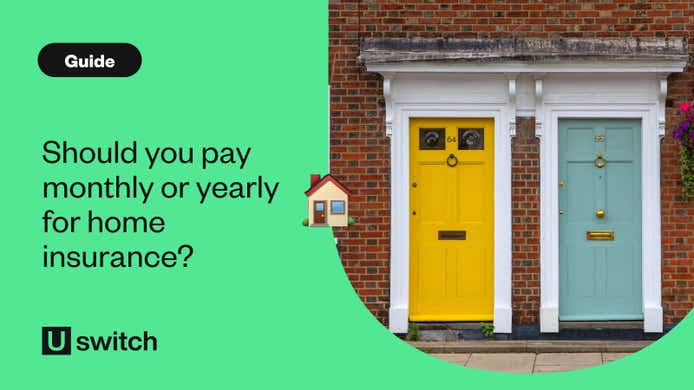Compare home insurance quotes
See a range of home insurance quotes in just a few minutes when you compare with Uswitch
Understanding building and contents cover
The best buildings and contents insurance is the one that suits your house or flat and the types of possessions you have inside. Depending on your living circumstances you may find that you only need buildings insurance cover or contents insurance cover for your home.
By searching Uswitch house and contents insurance you can find the best home insurance for your needs.
This Uswitch guide to building insurance and contents insurance will explain the key differences between the different insurance policies. We also explain how to compare home insurance quotes, and what factors you may need to consider before comparing the different home insurances.
What does buildings insurance cover?
A buildings insurance policy will provide you with the money to cover the costs of repairing or rebuilding your home should it be damaged or destroyed.
If you're a landlord or a homeowner then buildings insurance will be crucial, but if you're renting a property then buildings insurance is the responsibility of your landlord. However, as a tenant, you may wish to consider taking out contents insurance to protect your possessions.
Buildings insurance will cover the structure of your home – but can also include sheds, garages and other external features. These features aren't always included as standard, so make sure you check with your insurer in case you need extra cover.
A standard policy will usually cover you for the following:
- Floods
- Subsidence
- Theft/vandalism
- Fire
- Lightning damage
- Water damage
It's important to remember that when you're taking out buildings insurance - you need to cover your home for its rebuild value, not the market value if you were to sell it. Find out how to calculate how much home insurance you need and compare building insurance.
When do I need to buy buildings insurance?
If you already own a house then you should renew your buildings insurance each year when your policy comes up for renewal.
If you're already living in your home and you own it then you need to arrange buildings insurance cover as soon as possible. If your home were to burn down or be flooded you would be liable for all the repair costs unless you have buildings insurance.
When you're buying or selling a house or flat you need to arrange buildings insurance to cover the risk until the property is legally transferred. If you're in the process of buying a house you should take out buildings insurance to cover you from the point at which you exchange contracts (not the actual completion date, which will be later).
If you're the one selling the house you should keep your buildings insurance in place until the sale is completed and all documents are signed, just to be on the safe side.

How can I save money on buildings insurance for my home?
The best way to save money on buildings insurance is to shop around for the best quote. You can do this using the Uswitch buildings insurance comparison tool.
The best insurance is the one that covers your insurance needs, so make sure you include any outbuildings or garages in the quote if you need them to be covered. This way you can make a fair comparison between the different types of buildings insurance.
What does contents insurance cover?
Contents insurance policy will cover you for the cost of the possessions in your home should they be damaged or destroyed. Contents insurance will generally offer protection against the same perils as buildings insurance cover.
The Uswitch home insurance comparison can help you look at the different contents insurance policies on offer so you can match the best policy to your own personal needs.
How much home insurance contents cover do I need?
The most important thing you need to consider when calculating how much contents insurance you need is how much the contents of your home are actually worth.
It's likely that your contents are worth more than you think. In order to work out the amount of cover you need, you should go through every room in your house and note each item and its worth at today's prices. The figure will usually come to well over £30,000 on average. In fact, it may well surprise you when you add it all up.
Do I need to insure any valuable items separately?
Don't assume all your possessions are covered within your contents insurance policy; some providers insist that high value items (for example items over £1,000) must be insured separately from your main contents policy.
There are two different types of contents insurance:
- 'New-for-old' policies
- 'Wear and tear' policies
New-for-old policies will provide the full cost of repairing damaged items or replacing destroyed items. Wear-and-tear policies will repair damaged items, but with a reduction for depreciation and are generally cheaper as the claims will usually be smaller.
What type of items need to be insured separately?
High value items include laptops, bicycles, phones, jewellery, watches, painting and other art, and anything else which isn't ordinarily part of your house contents. If in doubt, ask your insurer if they need to be covered.
Also check the small print of your home contents insurance policy. Some insurers will cover bicycles and jewellery if they're lost or stolen outside your home, but many will not. If you think you might need this extra level of cover you may be able to add it on to your policy, but don't assume it's part of a standard home contents insurance policy.
Before you compare buildings and contents insurance
For a full guide on how to make your building and contents insurance cheaper, follow our seven steps to cheaper home insurance. However, there are some quick ways to save on your contents insurance before you start to compare buildings and contents insurance via Uswitch home insurance:
- Fitting a burglar alarm, joining local Neighbourhood Watch schemes, security lighting and other measures to secure your home
- Fitting a NACOSS alarm could earn you a discount of up to 7.5%
- Install a smoke alarm
- Increase the excess on your policy - if you are happy to cover more of the cost of the claim your premiums could be lowered
- No claims discounts - the less you claim, the lower your premiums will be. Some companies offer a no claims discount but check with them before you buy cover.
- Shop around and compare buildings and contents insurance quotes online
Do I have to take out buildings and contents insurance?
Unlike car insurance, you aren't breaking the law if you don't have building and contents insurance.
However, most mortgage providers will insist that you have buildings insurance before they will lend you any money, as your home is used as collateral in the event that you can't keep up repayments.
Beware of mortgage providers selling you expensive insurance policies alongside your mortgage. Compare buildings and contents insurance and get a cheaper quote elsewhere if you can. But you'll need to weigh up the cost of any exit fee, if applicable, versus the money you'll save.
What does house/home insurance cover?
Home insurance combined policies are generally both building and contents cover with the same policy. They will cover damage to your home and contents caused by such perils as flooding, fire, wind storms, hail, lightning, theft or vandalism.
Sometimes it's cheaper to arrange buildings and contents insurance with the same provider, but often you can save money by searching for them separately. Also, if you're buying a house, you will need to arrange the buildings insurance before the contents insurance (see above).
Can I get home insurance if I have a lodger?
Unfortunately, the Uswitch home buildings and contents insurance comparison service can't provide you with a home insurance quote if you have a lodger or rent out a room in your home. This is because our panel of insurers only cover people whose home is occupied solely by them and their family members.
However, this doesn't mean that you can't find home insurance elsewhere – many companies do provide cover for people with lodgers.
If you already have home insurance and want to take in a lodger, make sure you inform your insurance company – not disclosing this information could invalidate your contents and buildings insurance policy.
Circumstances that could invalidate your home insurance policy
There are a number of other changes to your home situation that could invalidate your contents and buildings insurance policy.
For instance, if you make significant structural home improvements such as, knocking down a wall, installing a loft conversion or putting an extension on the house, this could change the terms of your policy.
Not informing your insurer will cause problems for you should you need to make a claim later.
Similarly, you may need to inform your insurer if you live within proximity to a tall tree or flood-prone area, or have parts of your homemade from non-standard materials. For a full guide to non-standard home insurance claims, continue reading here.
Compare home insurance quotes
See a range of home insurance quotes in just a few minutes when you compare with Uswitch




